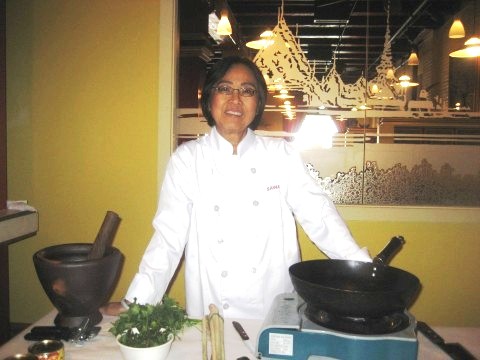Thai diet a good step toward balanced health
 Supenn Harrison
Supenn Harrison
Supenn Harrison teaches that life, like cooking, is best when done in harmony and balance.
Many people are aware of the health benefits of the Mediterranean diet but how many have considered the healthy aspects of the Thai diet?
The authentic Thai diet goes hand-in-hand with a spiritual lifestyle, according to restaurateur Supenn Harrison. To the Thai, diet and lifestyle are almost inseparable; both strive for balance and harmony.
Harrison, like 95 percent of native Thais, is a Buddhist of the Theravada school. Thai Buddhism is based on the religious movement founded in the sixth century B.C. by Siddhartha, later called the Buddha, who urged the world to follow the enlightened Middle Way.
She opened the first Thai restaurant in Minneapolis, Minn., (which was also the first in the Midwest) in 1979. Since then she has launched four more restaurants and remains closely involved in the day-to-day operations of two of them in Minneapolis, including purchasing all of the fresh ingredients for the Sawatdee menu.
“The practice of Buddhism has been infused into my cooking at Sawatdee and even in the way I run the business end of the restaurants,” says Harrison. “Buddhism integrates seamlessly as I go about my life as owner of a growing number of restaurants.”
When visiting one of the Minneapolis Sawatdee restaurants, it is common to see a small gathering of orange-robed monks seated in a back corner, eating, chanting or receiving alms during one of the many closely followed rituals of the Twin Cities’ small Thai Buddhist community. Harrison has for years provided space for introductory meditation classes for the public, scheduled every couple of months and taught by a monk from a nearby temple. Low attendance does not dissuade either Harrison or the monks. The idea is to have the space and opportunity available when others are ready to learn the ancient practice of relaxation and mindfulness. The mediation classes have been a catalyst in building positive relationships between the local Thai community and native Minnesotans.
Following the Buddha’s Eightfold path -- Right Understanding, Right Motives, Right Speech, Right Action, Right Livelihood, Right Endeavor, Right Mindfulness and Right Concentration -- appears to agree with Harrison. She’s a petite, energetic and friendly woman whose appearance belies her age by some 20 years.
Harrison came to the United States 37 years ago to attend college and teach. She taught, for a while, and also married and had two daughters, now adults. She did not adopt the American diet, however, and cooked Thai meals for family and friends. It was at their urging that she opened the first restaurant on Lake Street in Minneapolis.
Even though they were unfamiliar with strange ingredients, they came to love the unique blending of tastes that is the hallmark of Thai food.
Thai foods get their unique flavoring from balancing five different tastes: sour, sweet, salty, hot and bitter.
Sour tastes come from lemon, lime and tamarind. Sweets, used very sparingly in the Thai diet, come from palm sugar. Salty flavor is delivered through fish sauce, a Thai staple made from salt and fermented fish that is used like salt in western cooking or soy sauce in Chinese cooking. Chili peppers provide the hot and bitter comes from miniature egg plants.
In recent years Harrison began teaching how to blend three or four of these tastes in one dish. The popular classes cover the basics (fresh spring rolls and Tom Yum soup), to more involved recipes (Rama Delight, Red Curry and of course, Pad Thai) interspersed with tips for healthy living.
Medicinal herbs used in Thai cooking have preventative or curative qualities
Harrison said along with maintaining good sleeping and exercise habits, people should look to a combination of modern treatments and herbal remedies to stay healthy. Some of the healing herbs and spices used in Thai cooking offer specific health benefits, according to Harrison.
Kaffir lime leaves help prevent colds.
Garlic helps lower blood pressure and enhances sexual function in both men and women.
Chili peppers are rich in capsaicin. Capsaicin is one of the four methods for releasing endorphins in the body. The others, says Harrison, are exercise, sexual activity and prayer or meditation.
Galangal root stimulates the release of gastric juices to aid digestion and relieve bloating.
Turmeric, a plant from the ginger family, is used fresh like ginger in Thai dishes or ground into powder. It is believed to be beneficial as an antiseptic for cuts and bruises and for treating stomach problems.
Curcumin spice, a derivative of turmeric, is an antioxidant known in Thailand for having anti-inflammatory and anti-cancer properties. According to Thai herbalists, curcumin also helps wounds heal faster, reduces cholesterol, relieves arthritis and constipation, and provides relief for sore throats and coughs.
Cilantro not only cleans the breath after a spicy meal, but helps prevent cancer, says Harrison.
From one Thai restaurant to 50
Thirty years ago, the first Thai restaurant opened in the Twin Cities. Today, a search through the phone book lists more than 50. Are people simply crazy for Pad Thai or is something else afoot?

In a recent cooking class, Harrison pointed out that Thai food has gained in popularity as Americans recognize their health is in decline due to poor nutritional habits. “Over time, unhealthy eating catches up with people,” says Harrison. Too much reliance on processed and packaged foods has led to obesity, heart disease and increased rates of cancer, she added.
Fried, preserved and processed foods take longer to digest and eliminate, she said, and leave toxins that accumulate in the body. Thai food breaks down into smaller molecules much faster so the nutrients can be absorbed into the blood and carried to cells throughout the body.
The Thai diet relies on, for the most part, unprocessed foods including rice noodles, vegetables, roots, leaves and stocks. The exceptions are the fish sauce, pastes and curries that are imported from Thailand or India and used as flavorings. Meats, such as chicken, pork and beef, are used sparingly compared to American standards, if at all, or replaced with tofu.
It’s not that Thais don’t love food, says Harrison. In fact, their lives revolve around meals. They eat six or seven times a day but portions are very small.
“In the U.S., people eat very big meals. If I served a little serving of Pad Thai, people would never come back,” she says, referring to how her restaurant has adjusted serving sizes for American expectations.
Harrison is publishing a new cook book, her third, this fall. “Awaken to Thai Cooking” promises to be more than a cook book; it includes insights into Harrison’s Buddhist belief that life, like cooking, is best when done in harmony and balance.



 del.icio.us
del.icio.us Digg
Digg












This is a very enlightening article. I say that because although many people have eaten in a Thai restaurant at one time or another not everyone has a first-hand explanation of the 'raison d'être' of Thai cuisine to help them understand how and why their dish was prepared.
Next time I go to a Thai restaurant (which will be very soon believe me!) I shall consider my meal in a different light.
I imagine that many French people would find this article fascinating too, given that the French are well-known for their ability (albeit using a different philosophy and ingredients) to appreciate subtle blends of texture and taste....
I say that because although many people have eaten in a Thai restaurant at one time or another not everyone has a first-hand explanation of the 'raison d'être' of Thai cuisine to help them understand how and why their dish was prepared.
Thanks,
Brad
Post your comment